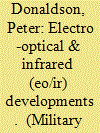|
|
|
Sort Order |
|
|
|
Items / Page
|
|
|
|
|
|
|
| Srl | Item |
| 1 |
ID:
139082


|
|
|
|
|
| Summary/Abstract |
Imaging sensors operating in infrared (IR) region of electromagnetic spectrum are gaining importance in airborne automatic target recognition (ATR) applications due to their passive nature of operation. IR imaging sensors exploit the unintended IR radiation emitted by the targets of interest for detection. The ATR systems based on the passive IR imaging sensors employ a set of signal processing algorithms for processing the image information in real-time. The real-time execution of signal processing algorithms provides the sufficient reaction time to the platform carrying ATR system to react upon the target of interest. These set of algorithms include detection, tracking, and classification of low-contrast, small sized-targets. Paper explained a signal processing framework developed to detect and track moving point targets from the acquired IR image sequences in real-time.
|
|
|
|
|
|
|
|
|
|
|
|
|
|
|
|
| 2 |
ID:
130764


|
|
|
|
|
| Publication |
2013.
|
| Summary/Abstract |
A reliable miniature cryocooler is one of the basic and foremost requirements for successful operation of high performance cooled infrared focal plane array (IRFPA) used for defence applications. Technological complexity and requirement of long duration fail-safe operation of the cryocooler demands robust design, fabrication and assembly with tolerances and, perfection of an array of sub-technologies. The paper presents the progress of the development activities in Stirling cryocooler technology at SSPL, which evolved through essential milestones like the development of single and dual piston linear motor driven split coolers to the state-of-the-art integral Brushless DC (BLDC) motor crank-driven type highly miniaturized coolers of capacities ranging from 0.25 to 0.5W at 80K. The theoretical investigations in the design of Stirling cycle cryocooler have been reported and the issues related to the design aspects are discussed in sufficient details. Experimental results of cryocooler performance tests are also presented. The paper also focuses on regenerator design optimization. The results of optimizations have been shown at the end considering a sample data.
|
|
|
|
|
|
|
|
|
|
|
|
|
|
|
|
| 3 |
ID:
156405


|
|
|
| 4 |
ID:
130761


|
|
|
|
|
| Publication |
2013.
|
| Summary/Abstract |
This short article describes the recent developments of cooled infrared products at Sofradir. These developments are driven by the future systems needs like the increase in resolution and detection range, the reduction of the detector size and consequently of the pixel pitch and the reduction of the power consumption. To answer to these needs, Sofradir develops in collaboration with the French infrared laboratory (CEA-LETI) new products based on Mercury Cadmium Telluride technology: Scorpio LW 640x512/15 µm pitch, sensitive in the long wavelength, Jupiter MW 1280 x 1024/15 µm pitch sensitive in mid wavelength, HOT detectors operating at 150 K and the 10 µm pitch detectors.
|
|
|
|
|
|
|
|
|
|
|
|
|
|
|
|
| 5 |
ID:
130762


|
|
|
|
|
| Publication |
2013.
|
| Summary/Abstract |
For the highest end mid-wave-infrared (MWIR) applications, SCD offers a family of cryogenically cooled detectors with background limited performance (BLIP). The matured InSb planar technology is implemented in a variety of focal plane arrays, from a 320 x 256 format with a 30 µm pitch to a 1280 x 1024 format with a 15 µm pitch, all of which are operated at 77K. A major challenge is to reduce the cooling requirements. Then substantial reductions in size, weight, and power (SWaP) can be achieved by using a smaller cooler and Dewar assembly. SCD's new epi-InSb detectors, grown by molecular beam epitaxy (MBE), have a BLIP temperature of ~100 K at F/3. This enhanced operating temperature reduces the required cooling power by ~20 % compared with the conventional 77 K operation. For a very high operating temperature, we have developed the new XBn-InAsSb detector with a 4.2 µm cut-off wavelength. This detector exhibits a BLIP temperature of ~160K at F/3 and a reduction in cooling power of ~60 %. These HOT detectors enable an improved range of solutions, including faster cool-down time and mission readiness, longer mission times, and higher cooler reliability. We can also exploit their reduced dark current to obtain an enhanced signal to noise ratio at lower operating temperatures. The well-established 25 µm pitch family of uncooled µ-Bolometer detector has two basic formats, 384 x 288 and 640 x 480, and several sensitivity grades. The very high sensitivity 25 µm pitch detector has been demonstrated at F/2.4 for mid-range systems. The wide-band detector is optimized for both the long-wave-infrared and mid-wave-infrared spectral bands. Recently we developed the new 17 µm pitch family of detectors. The 640x480 format is a leading candidate for applications such as thermal weapon sights, driver vision enhancers and other mid-range IR systems. The 17 µm family is currently being expanded with the high sensitivity grade and with the addition of two new formats: the compact 384 x 288 for low SWaP applications, and the large 1024 x 768 format for applications requiring high resolution and a wide field of view.
|
|
|
|
|
|
|
|
|
|
|
|
|
|
|
|
|
|
|
|
|